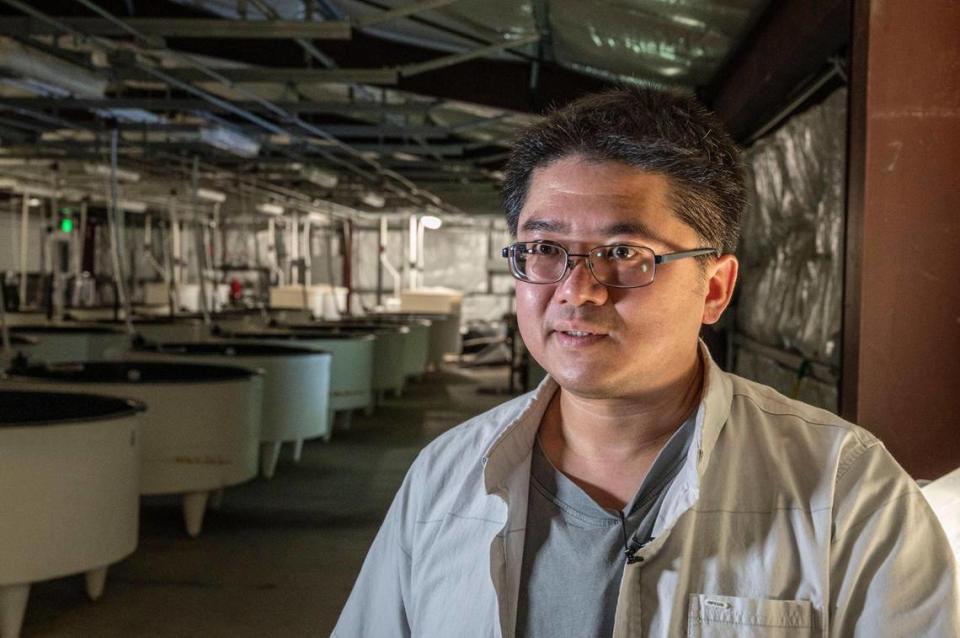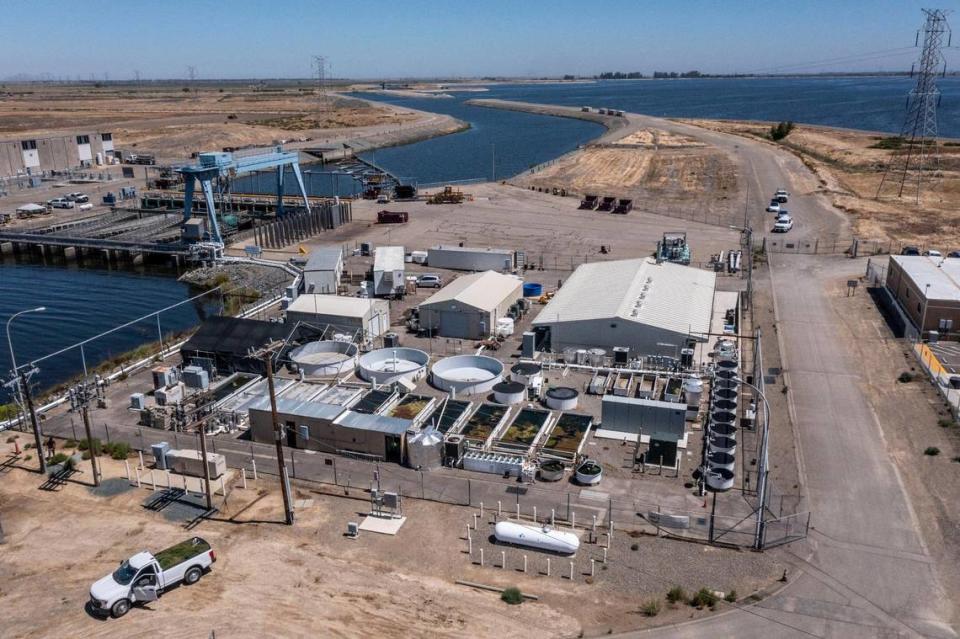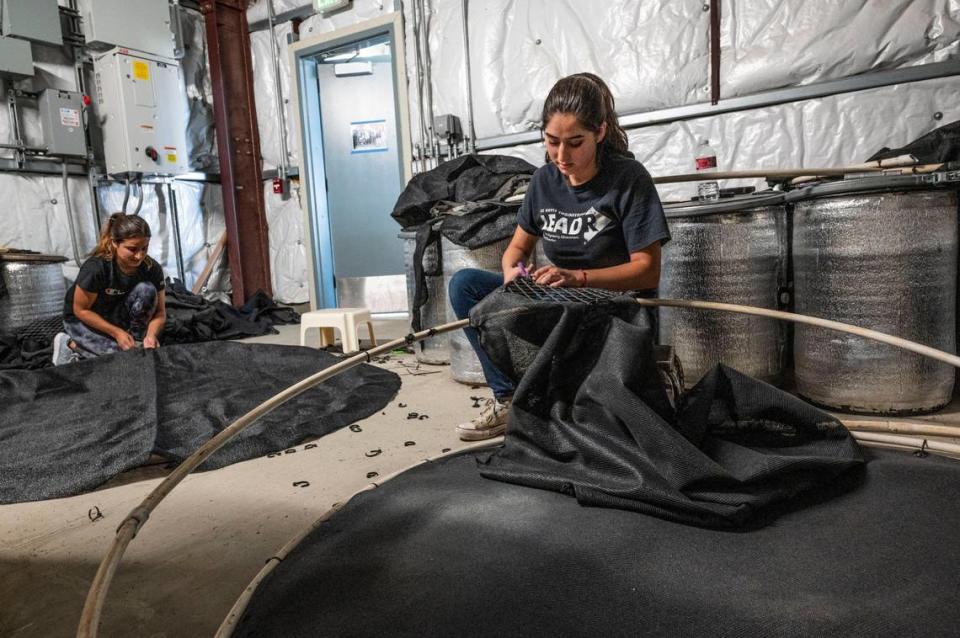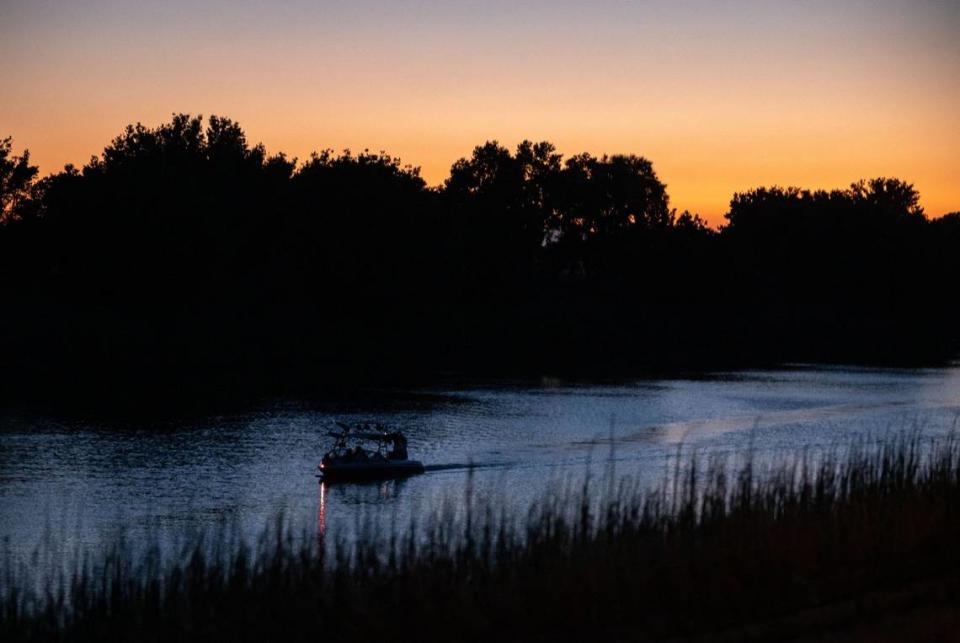Meet the man trying to save this ‘stupid little fish’ and see why he thinks it’s important
The fragile little fish that swim around in dark tanks in a lab are the last hope for their kind. The lab director who oversees their care, Tien-Chieh Hung, explained that when the Delta smelt captives are young, scientists at the UC Davis Fish Conservation and Culture Laboratory put snails in the black interiors of the tanks as a slow-moving mollusk cleaning crew.
The snails must do the work because the fish are so delicate, they could get tangled in a human cleaner’s arm hair and perish.
The whole project of painstakingly raising these temperamental endangered creatures, Hung said, may be futile — the smelt could just keep surviving in the lab because of human intervention, and vanishing in the wild because of human intervention.
With a California Delta habitat especially damaged by the rising temperatures and drought wrought by human-caused climate change and the unslakable thirst of people and farms in California, the smelt are perilously close to extinction.
“We do research, we try to do something for the earth,” Hung said. “There are just so many things to be done.”

It might not be enough to save the silvery fish, but it’s created a bizarre parallel world for these small creatures and the scientists who look after them, as well as for the visiting scientists who have much less experience with the smelt, and accidentally kill a bunch of them every time they handle the fish for research.
Significant Delta smelt populations only exist three places in the world: The Fish Conservation and Culture Laboratory at the mouth of the California Aqueduct, which Hung oversees; the Livingston Stone National Fish Hatchery at the base of the Shasta Dam, where Hung sends emergency fish in case something catastrophic happens to his own lab; and in their native California Delta, in precipitously dwindling numbers — as of this past winter, Hung sends reinforcements there, too.
Probably less than a thousand smelt are flitting through murky waters in the wild. In the rows of tanks in Byron, scientists care for more than 100,000 fish. And Hung, a wry former pesticides engineer, led the charge to release 56,000 captive fish in the winter for the first time, after years of debate.
He wasn’t sure they would make it in the “home” that had never been their home. “They might be too naive,” he said. “They might just become (a) buffet for bigger fish.”
But the scientists thought they had no choice, because with so few smelt in the wild, researchers couldn’t even find them anymore.
Months later, Hung smiled telling a reporter that at least some of the freed smelt were thriving. In an irony befitting the Delta smelt, Hung knew this because they’d been caught and killed in surveyors’ nets.
A smelt is drafted into a culture war
In a sense, Delta smelt can trace their controversial status to Republican President Richard Nixon.
A federal law championed by Nixon, the Endangered Species Act, prohibits people from driving another species out of existence.
“Nothing is more priceless and more worthy of preservation than the rich array of animal life with which our country has been blessed,” he said in 1973. “It is a many-faceted treasure, of value to scholars, scientists, and nature lovers alike, and it forms a vital part of the heritage we all share as Americans.”
Years later, the Delta smelt rose to fame as a casualty of California’s water wars: Because they are endangered — their numbers have been dropping since the 1980s — the government is obligated by law to protect them and their habitat.
In 1996, the lab was formed; it was not until 2008 that scientists there successfully spawned the fish in captivity. Their spawning behaviors in their wild habitat aren’t well understood.

And their wild habitat happens to supply millions of acre-feet of water to other parts of the state.
The smelt’s story resonates so much that then-presidential candidate Donald Trump brought up this “certain kind of 3-inch fish” on the 2016 campaign trail in Fresno. Trump acolyte and former U.S. Rep. Devin Nunes called them a “stupid little fish.”
As Tufts University sociology professor Caleb Scoville has written, the fish was only recognized as a unique species because of the water infrastructure that was threatening to destroy their home: “Building extractive infrastructure,” he said, “resulted in the proliferation of scientific knowledge about the natural systems it disrupted.”
And now, Hung and his team raise hundreds of thousands of tiny fish in dozens of tanks, less than 200 yards away from some of the water infrastructure that’s killing them.
The apparatus of survival for an endangered species
In captivity, the smelt have a peculiar life. They only spawn when a lab worker plucks them out of the water and squeezes them until they release eggs or sperm into a plastic dish. Their mates are carefully chosen by DNA testing through UC Davis’ Genomic Variation Lab.
“Basically,” Hung said, “it’s like a Match.com”.
The fish lab once had some wild-caught smelt that it brought in every year to maintain genetic diversity and make sure the captive fish weren’t getting too dissimilar from their wild brethren. But in the 2021-2022 season, the lab’s workers tried to collect the 100 wild smelt they’re permitted to capture every year. They couldn’t catch a single fish.
In the generations of smelt at the lab today, every one hatched in a little plastic tube and descended a little waterslide into a bucket, to be collected by scientists and carefully raised in a series of big, dark, circular tanks.
They retrieved the full 100 fish for the last time in the 2017-18 season, pulling in nets gently 15 times. The next season, the fish’s population had a steep decline. “We put out 10 times more effort” — 111 gentle pulls, Hung said — “but we can only get 28 fish.”
In the 2020-2021 season, workers set out a net and gently pulled it in by hand 451 times, more than 40 trips. They caught two fish.
“It’s so important,” Hung said, “to make sure one species is not going into extinction.”

Hung wasn’t sure what to expect releasing the 56,000 captives during December 2021 and January and February 2022. The permission to release the fish — a multi-agency deal — came fairly last-minute, and his team didn’t have much time to prepare. There was a chance the tiny, sensitive fish would all just die.
How well they’re doing is still unknown — less than 1,000 fully wild smelt, Hung said, were suddenly joined by 56,000 newcomers. Although the fin-tagged fish are popping up in surveyors nets — you can recognize the lab fish by the little gouges in their fins and the pop of neon color injected under their scales — the habitat these lab fish were introduced to was still the same Delta that was increasingly inhospitable to their species.
Farmers have cried out that they need the Delta waters that are being held back in part to protect this fish. Nunes and some of his former constituents believed the “stupid little fish” didn’t deserve all these protections.
In a way, Hung agrees with them: It kind of is a stupid little fish.
“People always ask this question: They’re asking, what happens if this fish disappears?” he said. “Will that affect the food chain? Will that affect the ecosystem?”
The answer, he said, is no: The fish are pretty much gone already.
“If they all disappear, nothing will change,” he said. But once the Delta is too hostile for the most fragile little smelt, then it will just get too hostile for the next-most-fragile animal.
“It’s important to keep diversity for ecosystems. …After the Delta smelt, there are just several other local species — they will disappear. They (are) already in danger.”

The next in line is likely the longfin smelt. The lab is working to help develop a refuge population for this species, too. The longfins are followed by a long procession of Delta lifeforms that could be wiped out.
He stood in a darkened room next to 33 tanks with about 1,000 smelt each, water pumps whirring as two students fashioned new covers for the tanks to keep out the debris and light that stress the fish out.
“We don’t want our ecosystem (to) become just one single survivor,” he said. If the smelt die, it’s bad news for the whole ecosystem — the ecosystem that people depend on, too.
Hung returned to his office. He sat at his desk, next to a collage by a more cynical photographer who’s trying to take a picture of every species that’s about to be gone forever. Hung had shown him around the lab a few years before, and Hung let him take pictures even though he’s trying to stop the outcome the photographer expects.
Because the smelt might be a stupid little fish, but if he gives up on them, he’s giving up on everything.

 Yahoo Movies
Yahoo Movies 
